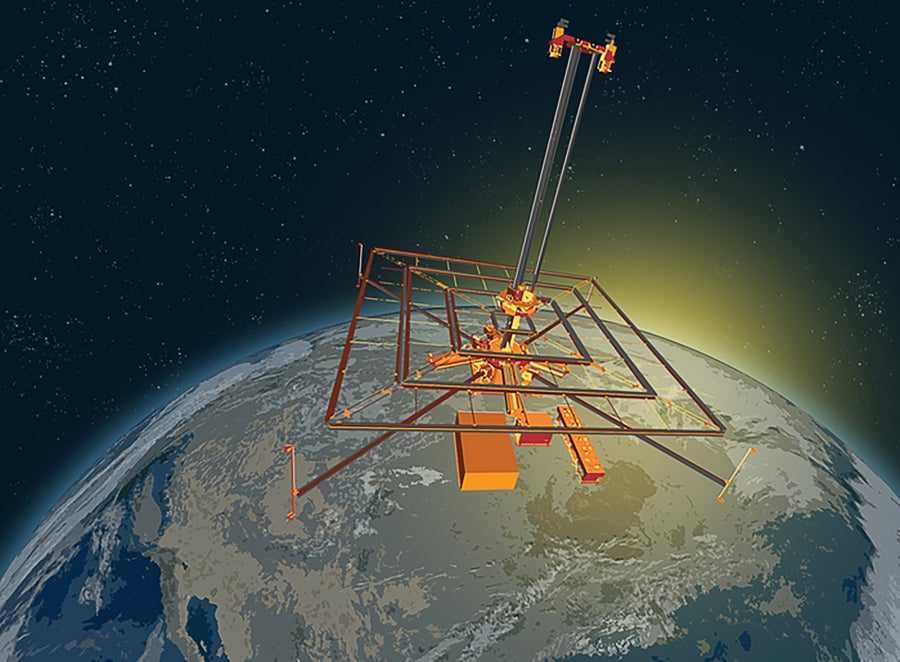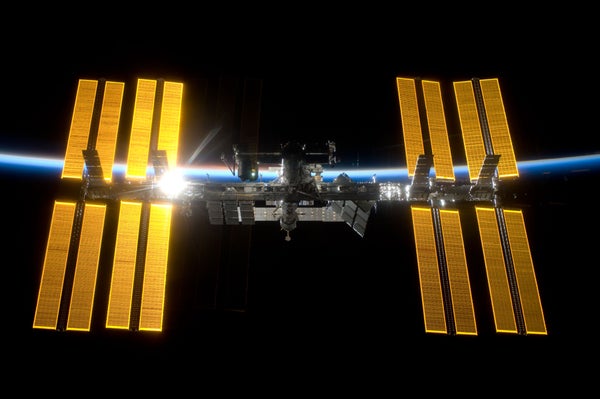The sun may be setting on NASA’s plans to build a space-based solar power (SBSP) satellite system to alleviate our energy needs on Earth. In January, the agency released a report that, citing launch costs specifically, concludes that generating power from orbit is simply too expensive, especially compared with solar power made right here on the planet’s surface.
That’s surprising because NASA has been interested in satellite solar power for half a century (other countries have been investing in research as well). Generating power in space for Earth-based needs, in some ways, makes sense. The sun shines continuously, 24 hours a day. There’s no air in space to attenuate sunlight, no weather to deal with, no clouds to block it. All you have to do is build a huge array of solar panels in orbit around Earth, convert the power they generate into microwaves, and then beam that to antennas on the planet’s surface, which convert it into electricity to send where it’s needed. In June, a Caltech prototype beamed power from space in this way for the very first time.
Of course, there are disadvantages. A big one is the efficiency of the microwave beam. It spreads out over distance, lowering the power received by an antenna on Earth’s surface. Also, any receiving antenna on the surface has to be huge, many square kilometers in area, which limits who can build them and where (it’s worth noting that the sci-fi trope of a dangerously powerful microwave beam causing havoc on the surface is at best an exaggeration; the beam’s energy density is far too low to have that sort of impact).
On supporting science journalism
If you're enjoying this article, consider supporting our award-winning journalism by subscribing. By purchasing a subscription you are helping to ensure the future of impactful stories about the discoveries and ideas shaping our world today.
This energy loss is exacerbated by the need to place the power satellite in geosynchronous orbit, approximately 36,000 kilometers above Earth’s surface. In low-Earth orbit (LEO), just a few hundred kilometers up, the power losses would be much smaller, but other disadvantages hugely outweigh that factor. The biggest is that satellites in LEO move rapidly relative to Earth’s surface, around eight kilometers per second. Any given spot on the ground can only see a satellite in LEO for a few minutes at best, so power transmission is severely restricted in time.
One solution to that is launching hundreds of individual satellites, so one is always visible at any time. Besides being incredibly expensive, the drawback there is light pollution. A single satellite with solar panels (and the large microwave antenna needed to beam the energy to Earth) would be incredibly bright, comparable to the full moon. Imagine dozens of these, hundreds, passing through the sky all night long, lighting up the heavens. Animal and plant life would be massively impacted, including birds, flowers, insects and even humans, all of which are affected by light pollution. It would also be the death knell of ground-based astronomy.
Placing power satellites in much higher orbits would mitigate many of these issues. A geosynchronous orbit is one that has a period of approximately 24 hours, matching Earth’s rotation. A satellite in such an orbit appears from the ground to stay fixed in the sky, so it would always be visible to the ground antenna. Only three would be needed to reach anywhere on Earth, though in reality it would take several more to be efficient. Still, they would be far fainter, likely about as bright as Venus in the night sky. An annoyance to astronomers but not a threat to their livelihoods.
The disadvantage is the larger distance, which means far more beam spread and the loss of power.

Artist's rendering of what the Space Solar Power Demonstrator looks like when unfolded.
Credit: Caltech/Space Solar Power Program
Delivering material to geosynchronous orbit and constructing the satellite would be pricey (perhaps, prohibitively so). For the NASA report, the authors based estimated costs on the SpaceX Starship rocket’s large payload capacity and lower launch costs per kilogram to orbit. They started with a nominal price of $100 million per launch, but also ran analyses with reduced ones of $50 million and $10 million a shot, assuming the price may drop in the future. Even so, the report finds it would take hundreds of launches, perhaps more than a thousand, to build a single SBSP system. When all is said and done, when a space solar power system comes online in 2050, the energy costs to the consumer would be anywhere from 12 to 80 times what it would be from ground-based systems.
Clearly, that’s not economical.
However, there are arguments to be made against the report’s methodology. For example, it assumes Starship will ferry the materials from low to geosynchronous orbit; that means refueling the huge vehicle in orbit, which in turn vastly increases the number of launches needed. As pointed out in the Space Review, electric propulsion tugs could instead be employed to take material on this last leg of its journey at much lower expense.
There’s also engineering, adding to costs. If humans are employed to build the system, they’d need housing on orbit, and a factory-like space station to assemble the massive wall of solar panels, which is an unaffordable premise. Better to automate the process using robots—except we don’t have the technology to accomplish that right now.
In fact much of the promise of SBSP relies on undeveloped tech. Starship, as an example, has not yet had a successful launch to orbit. While I am not one to bet against SpaceX, the fact is the vehicle is still far from being a reliable workhorse for a project that needs hundreds of launches. I would hesitate to wager my entire stake on an as-yet-unproven rocket. Once it’s up and running and has dozens of launches completed successfully—and the costs are better known—then will be the time to reevaluate its utility.
A SBSP satellite would be the size of a small city, many dozens of square kilometers of panels, not to mention the microwave transmitting antenna, which will be on the order of magnitude of a square kilometer. Nothing on the scale of assembling such a beast has even been done in space, and NASA’s history shows that endeavors on unprecedented scales always run behind schedule and well above cost.
Finally, while there are some advances being made to create an SBSP system, it’s not clear to me why we even need one at all. Ground-based solar production is advancing rapidly, with cost and implementation dropping in price precipitously. The addition of affordable, high-capacity batteries into the equation further lessens the need for a centralized power source.
In fact, ground-based power supply has many advantages over SBSP. Having on-the-spot generation (a municipal panel array, for example, or panels on a house) makes it easier to weather storms, since you don’t have to rely on long transmission pipelines from a centralized location like a ground-based receiver for SBSP. Satellites are also vulnerable to solar storms, and suffer degradation from radiation and micrometeorite impacts. Localized power generation is far more robust. If one breaks, you can fix it with a ladder and a replacement panel dropped off by delivery truck.
There may be uses for SBSP in the future, but at this moment in history it seems premature to invest heavily in them until more groundwork—figuratively and literally—is done. As the report concludes, further analysis can be done when capabilities are improved. Without a pressing need to spend hundreds of billions of dollars, at the very least, on SBSP, it makes more sense to wait and let NASA concentrate on its other obligations, which are facing their own headwinds.
This is an opinion and analysis article, and the views expressed by the author or authors are not necessarily those of Scientific American.
